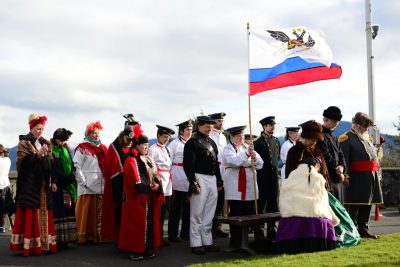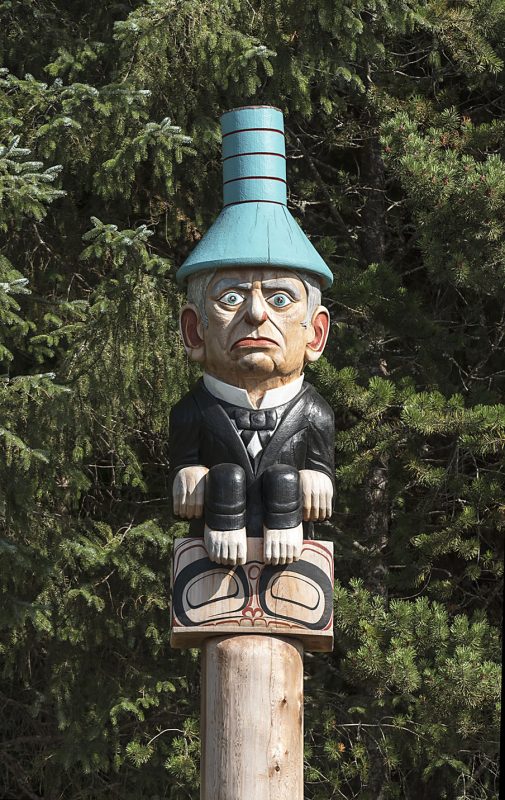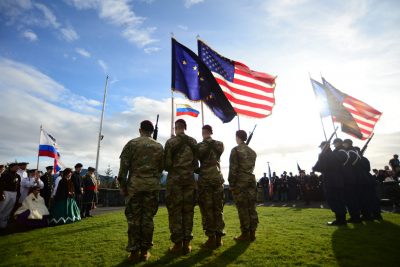Sesquicentennial matters in Alaska
05 March 2018 – Anna Lee Hirschi

Reenactors gather in Sitka on the 150th anniversary of the transfer of the territory of Alaska from Russia to the United States. Photo credit: Berett Wilber (used with permission)
Throughout 2017, Alaskans marked 150 years since the Alaska Treaty of Cession made the territory part of the United States. From Utqiaġvik to Ketchikan, people both celebrated and mourned a year of “history and heritage” (so designated by a proclamation from the governor) in dozens of ways. Nationally, as conversations around removing Confederate monuments and remembering histories of violence and racism occurred in places like Charlotteville and New Orleans, Alaskans also wrestled with difficult questions of public memory and commemoration. How do we mark a history that citizens both celebrate and lament? How does a state lift up our heroes and national identities without diminishing those who continue to mourn and bear the repercussions of a loss of land?
Historians, culture bearers, and Alaskan communities addressed these questions throughout the year. The Alaska Historical Society served as a hub for the commemorations, providing forums for dialogue and nuanced historical perspectives to communities around the state through its Resource Library as well as its support of community-led events. The year brought together community groups and historians, using primary sources, oral histories, historical analysis, and cultural narratives to reshape the state’s identity and publicly honor its difficult past.

Dionne Brady-Howard and other members of the Kiks.ádi clan gather to sing a mourning song on Alaska Day. Photo credit: Berett Wilber (used with permission)
The Alaska Historical Society collected articles from scholars to add depth and detail to the public narrative of Alaska’s history. Many people know that the territory was purchased for 7.2 million dollars in 1867, in a deal colloquially dubbed “Seward’s Folly,” but few people know that a Brooklynite threw a Fourth of July party in Sitka while it was still under Russian control (Chris Allan details this celebration in “Independence Day in Russian America?”). Steve Haycox explores the divisive post-Civil War political landscape in “Charles Sumner: Alaskan Hero,” while William Schneider points to the unusual legal precedent the treaty set for Alaska Native rights in his piece, “The Treaty of Cession and Alaska Native Rights.” Our Resource Library also documents the history of this anniversary’s commemorations, from Alaska Day’s origins in Seward (as Doug Capra details in “The City of Seward: Home of Alaska Day”), to Emily Moore’s telling of the creation of a totem pole shaming Seward for not returning the generosity shown to him during a potlatch in “Seward Shame Pole.” Ernestine Hayes raises important historiographical questions in “What Shall We Do with Our Heroes?” noting that this is also the sesquicentennial of Alaska Native resistance, and that the cultural trauma of this era must be part of how we remember the American past.

The most recent version of the Seward Shame pole at Saxman, Alaska, carved by Stephen Jackson. Photo credit: Hall Anderson (used with permission)
This history very much lives in the present, far beyond our articles, primary source collection, and think-pieces. How did Alaskans celebrate and mourn our history in 2017? Across the state’s 656,425 square miles, there were sesquicentennial-themed lectures, quilt shows, walking tours, a puppet show, and “fireside history chats” at the base of a glacier. There was a celebratory luncheon at the National Press Club in Washington, DC, and, on the same day, a healing gathering at Sheet’ka Kwaan Naa Kahidi led by the Sitka Tribe of Alaska. Books were published and conferences convened, from the Museums Alaska/Alaska Historical Society’s conference “Exploring the Legacy of the Alaska Purchase” to the Tlingit Clan conference, Wooshteen Kanaxtulaneegí Haa At Wuskóowu (Sharing Our Knowledge) in the days leading up to Alaska Day. Alaska Native Sisterhood leader Paulette Moreno carried a sign to the 2016 Alaska Day celebrations that read “Gunalchéesh Sheet’ka Kwaan for your care of Tlingit Aani for time immemorial” (Thank you Tlingit Clan, for your care of Tlingit land for time immemorial). This year, Kiks.adi tribal members gathered at the place of the treaty transfer to sing a mourning song, as Alaska Day marks the day they lost their land.

Reenactors and military personnel gather on Castle Hill/Noow Tlein in Sitka, Alaska during the flag transfer ceremony reenactment. Photo credit: Berett Wilber (used with permission)
Alaska’s history is often peripheral to mainstream American narratives, and the state’s historical and political complexities remain largely unknown. But the state’s efforts to center questions about diversity, identity, and complicated pasts offer a model to other communities grappling with their histories. While not perfect, the process has shown us that we can commemorate difficult history in a many-faceted way, following the lead of historians, culture bearers, and local knowledge networks. Historians’ work is vital to adding nuance and complicating widely-held narratives about the places and people who make up our state. This year reminds us that, even in this mercurial landscape, you can have both an armed salute and mourning song.
~ Anna Lee Hirschi is the Sesquicentennial project director for the Alaska Historical Society. A former resident of Sitka, Alaska, she currently lives in Cambridge, Massachusetts.



